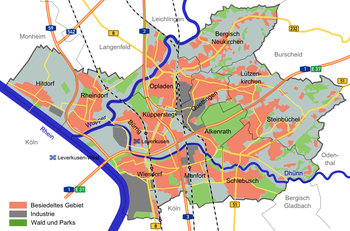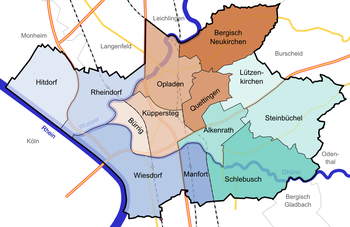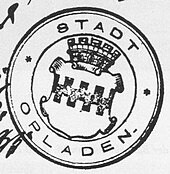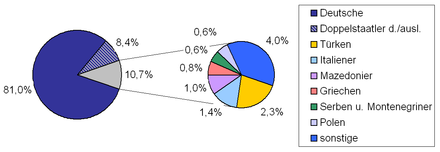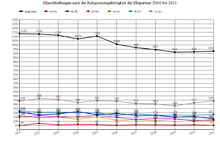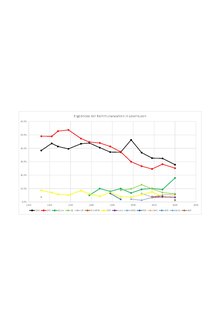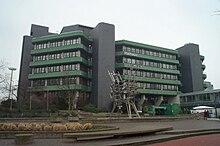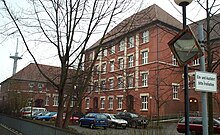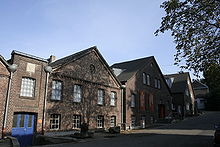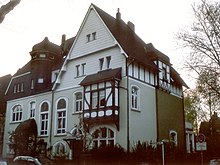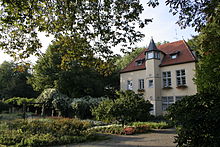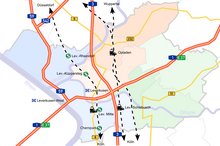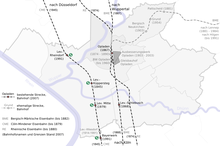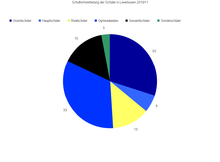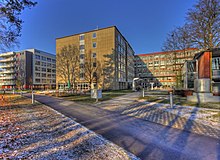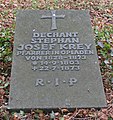Leverkusen
| coat of arms | Germany map | |
|---|---|---|

|
Coordinates: 51 ° 2 ′ N , 6 ° 59 ′ E |
|
| Basic data | ||
| State : | North Rhine-Westphalia | |
| Administrative region : | Cologne | |
| Height : | 60 m above sea level NHN | |
| Area : | 78.87 km 2 | |
| Resident: | 163,905 (Dec 31, 2020) | |
| Population density : | 2078 inhabitants per km 2 | |
| Postcodes : | 51371-51381 | |
| Primaries : | 0214, 02171, 02173 | |
| License plate : | LEV, OP | |
| Community key : | 05 3 16 000 | |
| LOCODE : | DE LEV | |
| NUTS : | DEA24 | |
| City structure: | 3 boroughs | |
City administration address : |
Friedrich-Ebert-Platz 1 51373 Leverkusen |
|
| Website : | ||
| Lord Mayor : | Uwe Richrath ( SPD ) | |
| Location of the city of Leverkusen in North Rhine-Westphalia and in the administrative district of Cologne | ||
Leverkusen [ ˈleˑvɐkuːzn̩ ] is an independent city and medium-sized center in southern North Rhine-Westphalia , belongs to the administrative district of Cologne , is geographically in the Bergisches Land and thus belongs to the Rhineland . In Leverkusen the Wupper flows into the Rhine .
The city is located immediately northeast of Cologne and belongs to the Rhine-Ruhr metropolitan region . With over 167,000 inhabitants, it is one of the country's smaller cities . Leverkusen is best known for the Bayer Group and the Bundesliga soccer club Bayer 04 Leverkusen . The city of Leverkusen was founded in 1930 through the merger of the city of Wiesdorf with the communities of Schlebusch , Steinbüchel and Rheindorf .
The city owes its name to the pharmacist and chemical entrepreneur Carl Leverkus , whose family descended from the Leverkusen court in what is now Remscheid . Around the middle of the 19th century, Leverkus founded a chemical factory near Wiesdorf am Rhein and named the settlement of its workers Leverkusen - that was the name of the family seat in Lennep . In 1930 the name passed to the newly founded city of Leverkusen.
The current city of Leverkusen was created in 1975 through the merger of Leverkusen with the district town of Opladen and the city of Bergisch Neukirchen and the incorporation of the Hitdorf district of the city of Monheim. The reorganized city was then divided into three city districts; in the process, Opladen was split into districts II and III. Leverkusen has three larger city centers with pedestrian zones. You are in the districts of Leverkusen-Mitte (Wiesdorf), Schlebusch and Opladen. Opladen is also known as the gateway to the Bergisches Land . Bergisch Neukirchen, Quettingen, Lützenkirchen , Steinbüchel and partly Schlebusch lie on the western slope of the Bergisches Land. The rest of the city is in the Rhine plain of the Cologne Bay .
The dialect spoken in Leverkusen is mainly the northern Middle Franconian dialect of Ripuarian , also known as the " Cologne dialect ". There are also Bergisch dialects in the eastern parts of the city.
geography
location
The city of Leverkusen is located on the right bank of the Lower Rhine , on the lower reaches of the Wupper and on the Dhünn . The natural city boundary in the west is the Rhine. About 10 km south of the city is Cologne , in the north Monheim am Rhein and Langenfeld (Rhineland) . The eastern districts extend into the foothills of the Bergisches Land .
The highest point of the urban area is on the city limits of Burscheid at the level of the Heiligeneiche composting plant at 198.7 m above sea level. NHN , the lowest at 35.1 m above sea level. NHN is located at the Hitdorf harbor entrance. The city limits have a circumference of 56 kilometers. The largest north-south extension is 8.9 kilometers and the largest west-east extension is 15.3 kilometers.
Neighboring communities
The following cities and municipalities border the city of Leverkusen, they are named clockwise , starting in the northeast:
![]() Leichlingen ,
Burscheid ,
Odenthal and
Bergisch Gladbach (all Rheinisch-Bergischer district ),
Cologne ( district-free city ) and
Monheim and
Langenfeld (both districts of Mettmann ).
Leichlingen ,
Burscheid ,
Odenthal and
Bergisch Gladbach (all Rheinisch-Bergischer district ),
Cologne ( district-free city ) and
Monheim and
Langenfeld (both districts of Mettmann ).
![]()
![]()
![]()
![]()
![]()
![]()
City structure
With the municipal reorganization in 1975, the urban area of Leverkusen was divided into three districts , 13 districts and 16 statistical districts. In 2003, 77 “neighborhoods” were delimited as a further subdivision. Each city district has its own district council , which consists of 15 members, the district representatives. They are elected by the population of the city district for a five-year term, chaired by the district chairman . The district representatives are responsible for certain tasks of the district and are to be heard on all important matters of the city district.
The city districts with their associated districts:
- District I: Wiesdorf , Manfort , Rheindorf and Hitdorf



- District II: Opladen , Küppersteg , Bürrig , Quettingen and Bergisch Neukirchen


- District III: Schlebusch , Steinbüchel , Lützenkirchen and Alkenrath


The districts are partly divided into further residential areas with their own names. These are older settlements or new building areas, the names of which mostly go back to historical names of farms, settlements or fields. These include, for example, Fettehenne, Pattscheid , Biesenbach , Hüscheid, Imbach , Niederblecher , Schöne Aussicht, Voigtslach, Mathildenhof, Leimbacher Berg, Meckhofen and Waldsiedlung.
Climate and nature
| Leverkusen | ||||||||||||||||||||||||||||||||||||||||||||||||
|---|---|---|---|---|---|---|---|---|---|---|---|---|---|---|---|---|---|---|---|---|---|---|---|---|---|---|---|---|---|---|---|---|---|---|---|---|---|---|---|---|---|---|---|---|---|---|---|---|
| Climate diagram | ||||||||||||||||||||||||||||||||||||||||||||||||
| ||||||||||||||||||||||||||||||||||||||||||||||||
|
Average monthly temperatures and precipitation for Leverkusen
Source: DWD, data: 2015–2020
|
||||||||||||||||||||||||||||||||||||||||||||||||||||||||||||||||||||||||||||||||||||||||||

Leverkusen extends over three Rhenish landscape areas: the Cologne-Bonn Rhine plain, the Bergische Heideterrasse and the Bergische plateaus. On the Cologne-Bonn Rhine Plain there are linden forests, the edges of the brooks and rivers are overgrown with swamp and floodplain forests, with a small proportion of oak and hazel, which is also present in the linden forests. The landscape of the Bergische Heideterrassen is predominantly characterized by heather , which is also part of the name of some parts of the city such as Fixheide or Schlebuscher Heide. To the east lies the Bergisches Hochland as part of the Rhenish Slate Mountains. Mainly coniferous wood cultures were planted there. In addition, this area is used for agriculture.
The annual average rainfall in Leverkusen is 700 millimeters, the wind mainly blows from the west and southwest. The annual mean temperature is approx. 12.2 ° C. In the east towards the Bergisches Land, the amount of precipitation increases to an annual mean of up to 1,300 millimeters. The climate thus corresponds to the transition from a temperate maritime climate to a continental climate with mild winters and moderately warm summers.
story
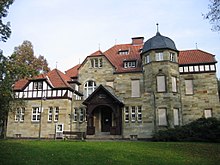
The history of Leverkusen presented here essentially relates to the communities of Wiesdorf, Schlebusch, Steinbüchel and Rheindorf, which merged in 1930 to form the city of Leverkusen. Details on the history of the districts that were added to the city of Leverkusen in 1975 can be found under Opladen , Hitdorf and Bergisch Neukirchen .
The settlements of today's Leverkusen city area were first mentioned from the 10th century, first Hitdorf in 941, the last Alkenrath in 1458. They belonged to the county or to the Duchy of Berg since the Middle Ages .
Roman times
Grave slabs were found in Leverkusen that could be assigned to the Romans due to their design and the contents of the grave . The graves contained, among other things, complete military equipment . Another indication of the presence of the Romans in the later Leverkusen city area are settlements that were built according to the Roman model. The Scherfenbrand settlement and many other small camps in Leverkusen could, among other things , be assigned to the Romans on the basis of terra sigillata found . The Romans were replaced by the Franks in the first quarter of the fourth century AD . At the time of Charlemagne , the Leverkusen area belonged to the Deutzgau .
middle Ages
The country on the right bank of the Rhine belonged to a large extent to the powerful Archdiocese of Cologne, including Leverkusen. A property in Rheindorf was mentioned in the 11th century in connection with the Cologne Apostelstift. Hitdorf, on the other hand, was mentioned in 1151 with its St. Pantaleon Abbey and a Fronhof in which a subordinate of Count von Berg lived.
Since around 1150, the counts (and later dukes) von Berg had power over what would later become the city . The Bürrig parish church was mentioned for the first time in 1147, followed by the churches in Lützenkirchen and Wiesdorf in 1163 and 1164; the Schlebuschrath church was first mentioned in a document in 1235.
In the 14th century the parish churches of Wiesdorf , Rheindorf , Bürrig , Opladen , Lützenkirchen and Neukirchen (today Bergisch Neukirchen ) were listed in the tax directory of the Cologne archdiocese , the Liber Valoris . This archival register of the medieval archbishopric administration was reissued again and again at least from the 13th to the 15th century. For the year 1363, the districts of today's Leverkusen are occupied as places in the Miselohe office (with the exception of Hitdorf and Rheindorf, which belonged to the Monheim office). Opladen played a central role in the Miselohe office as the seat of the court and the office physician .
The farmers in Leverkusen and Bergisches were independent comparatively early on, without having to do compulsory labor, which made a rise in the social hierarchy possible.
Beginning of the modern age
At the beginning of modern times, the majority of the population lived from agriculture and forestry. The population had also risen in the municipalities of today's Leverkusen, such as Bürrig, Wiesdorf or Küppersteg. Exact information cannot be given as there are no church books that could provide information about the 15th and 16th centuries. The largest communities were probably Wiesdorf, Schlebusch and Lützenkirchen, which are said to have had a population of just under 1000. On the other hand, Rheindorf and Bürrig are rated as smaller; they were considered small parishes .
Conditions in the Cologne War
During the Cologne War (1583 to 1588), many villages, both in today's Leverkusen city area and in the surrounding area, were plundered and devastated by the troops of Count Palatine Johann Casimir . Leverkusen was repeatedly hit by raids in the catchment area from south to north along the Rhine . The troops, which first occupied Bonn and then moved to Mülheim and Deutz, marched past the Leverkusen settlements and plundered. An abbess from Gevelsberg reported:
“When the Truchsian war people were located in Stammel, Mulheim, Duitz and the Orth (Wiesdorf) for a long time, the Halfmann was not only robbed of full barns, but also all cattle, straw, food and drink were robbed so that he could stay with strangers People had to feed. "
The castle, now Bürrig , was attacked and the village church was destroyed, as was the chapel in Schlebusch. Both church buildings were rebuilt after the war.
Leverkusen at the time of the Thirty Years War
Today's urban area has always been on a north-south route that is also important for warfare. As the effects of the Cologne War subsided, the tribulations of the Thirty Years' War followed. When the armistice between Spain and the Dutch ended in the Thirty Years' War , little happened in the Rhineland at first - this area was still affected by the Cologne War. Only later did troops move through the Bergisches Land and with it the present-day urban area of Leverkusen, which invaded the surrounding duchies and counties. In 1622, the first Spanish troops came and quartered in Mülheim . In 1625 the area was occupied by the troops of the imperial Count of Anhalt , who let the peasants do tension work. At the request of the city of Wipperfürth, the Count of Anhalt's troops were withdrawn, but Spaniards came again in 1625 and were relieved by Hessian troops in 1626. It was followed by Spaniards who plundered and robbed again. The acts of war only stopped after 1643. Some houses in Wiesdorf, Schlebusch and Dünnwald were raided again and again during this time, even though the Thirty Years War in the Leverkusen city area was rather mild compared to other cities.
1648-1815
The later Leverkusen urban area was only sparsely populated before the 18th century and at that time consisted of small communities, courtyards and individual houses. None of the settlements reached more than 1500 inhabitants or were to be regarded as small towns. The core areas of today's districts of Leverkusen (e.g. Opladen, Rheindorf, Wiesdorf, Bürrig, Lützenkirchen, Schlebusch or Neukirchen) were the smallest communities at that time, in which the churches served as the focal points of the surrounding individual farms, hamlets and houses; a total of around 9,000 people lived in this area. The comparatively thin settlement for a later large city is not uncommon in comparison to the entire German area: While around 116 inhabitants per square kilometer lived in the Leverkusen city area , this number was an average of 45 inhabitants / km² in the entire federal area. In the rest of the Rhineland, which is one of the most densely populated areas in Germany today, the settlement density was only around 99 inhabitants / km². At that time, Lützenkirchen was the largest town in what is now Leverkusen, with 1845 inhabitants, followed by Neukirchen and Hitdorf.
The Duchy of Berg was ceded to Napoleon in 1806 and expanded to form the Grand Duchy of Kleve-Berg . The administrative structures were reorganized as a result, and since 1808 the Leverkusen area belonged to the municipalities of Opladen and Schlebusch of the canton of Opladen, Arrondissement Düsseldorf, Département Rhine .
1815-1933
In 1815 today's Leverkusen area came due to the resolutions of the Congress of Vienna under Friedrich Wilhelm III. to Prussia , which assigned it to the province of Jülich-Kleve-Berg , or from 1824 to the Rhine province . Due to the occupation patent , all residents of the Rhineland and Westphalia became Prussian subjects. In 1815, Opladen was initially the seat of a district , but it was dissolved in 1819 and its area was incorporated into the Solingen district. Today's urban area has been divided into the two municipalities of Opladen and Schlebusch since 1816 . In 1857 Neukirchen (from 1904 Bergisch Neukirchen) and Hitdorf and in 1858 Opladen were elevated to town status. While Lützenkirchen, Steinbüchel and Schlebusch continued to form the Schlebusch mayor after 1856, the town of Opladen and the mayor of Opladen-Land, consisting of Wiesdorf and Bürrig, were initially administered in personal union. This ended in 1889, and the mayor's office in Opladen-Land changed its name to the mayor's office in Küppersteg.
In 1861, Carl Leverkus , a trained pharmacist from Wermelskirchen , relocated his ultramarine factory near the community of Wiesdorf on the Rhine . It was originally located in Wermelskirchen in the Bergisches Land , where it could not be held due to very poor traffic routes. Many factory workers therefore moved to the communities in what is now Leverkusen. Carl Leverkus named the resulting factory settlement Leverkusen after the ancestral home of his family , a court between Lennep and Bergisch Born (today districts of Remscheid ). A year later, the ultramarine factory had 78 employees. Leverkus began to set up social facilities in the settlements for its employees, who had largely relocated from Wermelskirchen.
Friedrich Weskott and Friedrich Bayer founded Bayer et comp in 1863 . in Barmen (today part of Wuppertal ). In 1866, due to problems with sewage disposal, the company was relocated to a river, initially to Elberfeld on the Wupper. Carl Duisberg joined in 1884 and helped shape the company's economic progress.
The Leverkus company, which developed parallel to Bayer AG in Leverkusen and was led by Carl Leverkus , wanted to give up its Alizarin production, which was economically on a bad course, and in the process sell the entire industrial plant.
In 1891 Bayer AG relocated its company to Leverkusen. Shortly beforehand, the Leverkus board of directors had approved the sale of Leverkus to Bayer. In this way, a large part of the works could be taken over directly. While the old factory premises of the Leverkus company were being renovated, Carl Duisberg planned new factories around the old premises, which later also contributed to the economic success.
With the relocation of the Bayer company from Elberfeld to Leverkusen, many people looking for work came to Leverkusen again - most of them former factory employees from Elberfeld. Main production was not finally relocated to the Rhine until 1901, but many recognized this early on and moved to Wiesdorf in the Leverkusen factory settlement. New residential quarters had to be built there, which were often very small, cramped and unsightly. A great displeasure spread among the Leverkusen workers, so that they finally sang:
- Can't you crumple you
- If you send him to Leverkusen.
- There at this end of the world
- You are forever frozen.
A year later, the name Leverkusen was also used by the post office within the factory premises.
The Prussian State Railways founded the main railway workshop in Opladen in 1903, which in the following years developed as a repair shop in Opladen until it was closed in 2003 and became one of the largest employers in the current urban area alongside Bayer AG. Due to the growth spurt that this triggered and the initiative of District Administrator Adolf Lucas , Opladen became the district town of the Solingen district in 1914 , after the city of Solingen had meanwhile become independent . For economic reasons, it was favorable for Wiesdorf and Bürrig to merge to form the community of Wiesdorf, which was approved on April 1, 1920. In February of the following year, she was granted city rights. This integration was the beginning of the merging of the districts of today's Leverkusen, the granting of city rights an additional signal that another center was developing in this area in addition to Cologne and Düsseldorf.
At the end of the 1920s, the economic situation in Wiesdorf was good, but there was a housing shortage in the city as more and more workers were moving to the region. For this reason Wiesdorf began to negotiate incorporation with Schlebusch . In 1928, the mayor's office of Schlebusch decided to start negotiations with Cologne. A referendum favored the merger of Schlebusch with Wiesdorf. In 1929 negotiations with Cologne were broken off. The communities of Steinbüchel and Rheindorf, like Schlebusch, were incorporated into Wiesdorf on April 1, 1930. The name of the new town that was created in this way was chosen as the name of the factory settlement, which has been in use since 1862 and connected the three communities: Leverkusen .
The new city of Leverkusen belonged to the Solingen-Lennep district, which was formed in 1929 from the Solingen and Lennep districts and was renamed the Rhein-Wupper district in 1931 . Opladen was significantly enlarged in 1930 through the incorporation of the community of Lützenkirchen (including Quettingen, but excluding Hamberg and Dürscheid, which came to Burscheid). In the years that followed, Leverkusen developed into an industrial city that was particularly shaped by Bayer AG and, for example, promoted and supported by cultural institutions. This connection between the Bayer plant and the city is also highlighted in the literature:
“ A dominant feature, however, is a connecting element that rules the cityscape, regardless of whether you are traveling up the Rhine by ship […] whether you are arriving by train or the motorway […]: a huge one leaning westward on the Rhine and northward on the Wiesdorf settlement center Industrial plant [...]. "
In other contexts, the merger to Leverkusen is described as incomprehensible, the districts as inappropriate and the result as an “administrative act” and “large community”. Westecker described Leverkusen in his work on German cities as a “curiosity” and “city without a past”. Nevertheless, the merger was considered sensible from an economic point of view, not least because not only Cologne, but also parts of the Bergisches Land, including Solingen, had expressed interest in today's Leverkusen districts. The mayor at the time, Heinrich Claes , felt compelled to push ahead with the merger. Today he is seen as the "father of union".
National Socialism and World War II
As early as March 7, 1933, the city government was overthrown and the swastika flag was raised as a sign of the Nazi takeover of power. The then mayor Claes initially did not take action against it. Rather, he tried in vain to cooperate with the new government, not out of political conviction, but because he did not want to give up his influence on the city and did not want to end his term in office in this way.
The National Socialists finally took power on March 30, 1933 . As in the rest of the Reich, all leadership positions in Leverkusen were taken over by National Socialist politicians. Mayor was Wilhelm Tödtmann ( NSDAP ), who took over the provisional management of the city. The NSDAP hindered the other parties in the election campaign. National Socialists were appointed to the boards of the larger companies and organizations. The influence of the party became particularly evident in the renaming of many streets and squares; For example, Rathenaustrasse was renamed Adolf-Hitler-Strasse, the square at the town hall was renamed Adolf-Hitler-Platz and Bebelstrasse was renamed Hermann-Göring-Strasse.
Some residents of Leverkusen were sent to forced labor camps. In the administrative report of the city of 1936 you can read:
"The placement, mainly single welfare recipients, to the Üdelhoven id Eifel labor camp was continued [...] Even if the value created by the work done does not benefit the city of Leverkusen or the Rhein-Wupper district, placement according to the Üdelhoven camp the opportunity to try out the will to work of people who are difficult to convey or who are not very enthusiastic about work. "
On January 1, 1934, the law for the prevention of genetically ill offspring came into force. This year there were already three cases, a total of 23 people were reported for forced sterilization. The administrative report of 1937 states:
"According to the general accounts of the State Welfare Association for 1934, 113 mentally ill people from the city district were accommodated [...]."
Anti-Semitism first manifested itself in the slander of Jewish citizens and business people and the deprivation of their economic base. However, the residents of Leverkusen knew many Jews personally and were initially reluctant to give up their usual shopping habits. There were also people who stood by the Jews, for example the pastor of the Herz-Jesu-Kirche in Wiesdorf, Wilhelm Klingenberg, who spoke out against discrimination against Jews in his sermons and also helped many Jews to hide. During the Reichspogromnacht , the windows of Jewish shops in Wiesdorf and Opladen were destroyed, and the Opladen synagogue was burned down. That night, the Opladen fire brigade limited itself to protecting adjacent half-timbered houses. At the former location there is now a memorial plaque commemorating this center of Jewish community life.
In Opladen there were violent conflicts with the ruling National Socialists. As early as 1934 there were plans to close the church Aloysianum . The director, Senior Studies Director Peter Neuenheuser , was harassed by the SA and the Hitler Youth after he had banned students from attending an anti-church Hitler Youth event. He was taken into protective custody and had to leave Opladen afterwards. In 1938 the Aloysianum was finally closed. Hermann Milde, pastor at St. Remigius , who had expressed himself critical at a parents' meeting on the occasion of the closure, was expelled from the district. The students were forced to switch to other schools, and the building continued to be used as a vocational school and Opladen town hall, instead of the Villa Römer , which had served as town hall since 1933 . The Marienschule had to cease operations by various reprisals Easter 1940th The rulers also pushed through their ideas in the city's high school . Inconvenient teachers were given leave of absence or forcibly transferred after the school had already been named Adolf-Hitler-Realgymnasium in May 1933 at the instigation of the city . Youth groups were forcibly integrated into the Hitler Youth. The membership of the NSBO grew from 12 to 2,500 between February and May 1933.
The National Socialist press repeatedly complained about the lack of interest and the rejection of broad circles of the Opladen population. The local newspapers Bergische Post and Allgemeine Zeitung were occasionally critical of the political situation until around 1935, for which they were banned several times at short notice and finally closed for good .
The Second World War had the first direct impact on Leverkusen on November 7, 1939, when British and German airmen fought an aerial battle over Leverkusen. On the night of June 5, 1940, there was the first air raid , in which, among other things, the Niederblecher settlement was hit. Just a few days later, bombs fell on the paint factories and caused great damage. At the same time, bombs fell on Küppersteg, where parts of the railway systems were destroyed.
The Bayerwerk in Leverkusen, which is now part of the IG Farben Group, maintained production in the war years 1940 to 1944 through the use of 9,000 mostly Eastern European forced laborers . In January 1943 there were again air raids, this time on the dynamite factory in Manfort . Finally, in August and November 1943, carpet bombs also fell in Leverkusen . After the declaration of shots war by Joseph Goebbels 93 bombs fell on September 10, 1944 Manfort. The heaviest attack hit Leverkusen on October 26, 1944, when a total of 1,017 high-explosive bombs and around 12,000 incendiary bombs fell. 124 people were killed in this attack and there was enormous property damage. Air raids on the Reichsbahn repair shop in Opladen, especially between December 1944 and March 1945, claimed many lives and also caused great damage.
On April 15, 1945, the war in Leverkusen ended after artillery fire and a bridge blow, which was only partially prevented. Mayor Simon handed the city over to the American armed forces.
Leverkusen after the Second World War
After the Second World War , Leverkusen was in the British zone of occupation . The seat of the district military government for the Rhein-Wupper district was in the Villa Römer in Opladen; From June 18, 1945, the military government issued the official communications for the Rhein-Wupper district . In Opladen there was a military court established by the occupiers . After the very tight supply situation in the cities in Germany, the worst famine was resolved by 1948 and the economy revived. The transport infrastructure was also largely rebuilt by 1948.
On April 1, 1955, Leverkusen left the Rhein-Wupper district and became an independent city . At that time the city had about 78,000 inhabitants. A steady population growth led to the city limit of 100,000 inhabitants being reached in 1963 . The town of Hitdorf was incorporated into the town of Monheim as early as 1960 .
On January 1, 1975, the previous cities of Leverkusen, Opladen and Bergisch Neukirchen were merged to form the new independent city of Leverkusen as part of the North Rhine-Westphalian territorial reform in accordance with Section 17 of the Cologne Act , despite some fierce resistance from the council and the population of the cities concerned . At the same time, the Hitdorf district belonging to the city of Monheim was incorporated into the new commune, which thus reached its current size. The Rhein-Wupper-Kreis was dissolved. Since then, the Leverkusen area has been part of the Rheinisch-Bergisch district or the Mettmann district . The latter remained in the Düsseldorf administrative district , while Leverkusen has since been part of the Cologne administrative district.
population
Population development
In 1905 Wiesdorf had around 10,000 inhabitants, by 1914 this number had doubled to more than 20,000. After the merger of the city of Wiesdorf with the communities of Schlebusch, Steinbüchel and Rheindorf to form the city of Leverkusen on April 1, 1930, it had around 40,000 inhabitants. In 1963 the city's population exceeded 100,000, making it a major city . After the expansion to include the cities of Opladen (45,604 inhabitants 1974), Bergisch Neukirchen and Hitdorf on January 1, 1975, the population of Leverkusen reached its all-time high of 167,671. According to the federal German census, Leverkusen had 158,984 inhabitants on May 9, 2011. On December 31, 2017, Leverkusen had 163,577 inhabitants.
The figure shows the population development of the predecessor communities and of Leverkusen in today's urban area. The influences of industrialization from the second half of the 19th century are clearly visible, in particular the settlement of the Bayer company in 1891, the influence of the two world wars, the again stronger rate of increase after the Second World War, the influence of the pill break around 1970 and finally the economic one Recession in the 1980s.
The population is broken down by age as follows (as of September 30, 2016):
| Age group | total |
| 0 to under 3 | 4,627 |
| 3 to under 6 | 4,513 |
| 6 to under 10 | 6,067 |
| 10 to under 16 | 9,355 |
| 16 to under 18 | 3,358 |
| 18 to under 21 | 5,185 |
| 21 to under 25 | 7.211 |
| 25 to under 45 | 40,702 |
| 45 to under 65 | 49,541 |
| 65 and older | 35,603 |
| in total | 166.162 |
Demographics
In October 2019, 167,433 people had their place of residence in Leverkusen, 85,448 of them female and 81,985 male. 27,565 inhabitants were non-Germans; this corresponds to a proportion of foreigners of around 16.5%.
57,623 inhabitants (approx. 35.2%) had a migration background in 2018. Of the total of 4,989 children in day-care centers, 2,061 (41.3%) have a migration background.
Of the 166,537 inhabitants (as of June 2020), 28,428 are minors (17.1%) and 35,786 are over 65 years old (21.5%).
In 2017, 82,300 people were employed in Leverkusen. About 72.8% of this was accounted for by the service sector, 27.1% by the manufacturing industry and 0.1% by agriculture, forestry and fishing.
In 2016, 79,546 residents of Leverkusen were gainfully employed, of which approx. 49.6% commute. With 59,844 people, 75.2% of the working population were employed subject to social security contributions.
Marriages
Compared to 2001, the number of marriages per year fell by approx. 18% to 929 in 2011; in 2001 there were 1133. On the other hand, the number of marriages for partners who both belong to the Protestant Church fell by 6.1% from 49 to 52, and for those who both belong to another or no religious community by 0.3% increased from 338 to 339.
For spouses who both belong to the Catholic Church, the number of marriages fell by 39.5% from 210 to 127, for spouses where one is Roman Catholic and the other is Protestant, the number is 18.8% from 149 to 121, for partners in whom one belongs to the Protestant church and the other to another or no religious community, the number has fallen by 33.9% from 165 to 109, and for spouses in whom one part of the Roman Catholic Church and the other part of another or no religious community, the number of marriages fell by 18.5% from 222 to 181.
politics
City Council

The Council of the City of Leverkusen has 52 seats (as well as a vote for the Lord Mayor), which are distributed among the individual parliamentary groups or parties as follows (as of September 13, 2020):
| CDU | SPD | GREEN | CIVIC LIST | OP | FDP | AfD | The left | Departure from Leverkusen | Büfo - climate list | total |
|---|---|---|---|---|---|---|---|---|---|---|
| 14th | 13th | 9 | 3 | 3 | 3 | 3 | 2 | 1 | 1 | 52 |
The CDU holds the most seats in the city council with 14 seats, followed by the SPD with 13 seats.
Lord Mayor
In North Rhine-Westphalia, the dual leadership of the city administration, consisting of senior city director and lord mayor, was given up in 1994 and merged into the office of full-time lord mayor. He is the chairman of the council, head of the city administration and representative of the city. He is elected directly by the electorate and his term of office is five years.
(Mayor) since 1930
| period | Surname | Political party |
|---|---|---|
| 1930-1933 | Heinrich Claes | center |
| 1933-1938 | Wilhelm Tödtmann | NSDAP |
| 1938-1945 | Ludwig Simon | |
| 1945 | August Adolphi | SPD |
| 1945-1946 | Heinrich Claes | CDU |
| 1946-1949 | Johannes Dott | CDU |
| 1949-1951 | Johannes Ritter | SPD |
| 1951-1954 | Johannes Dott | CDU |
| 1954-1961 | Wilhelm Dopatka | SPD |
| 1961-1964 | Heinrich Lützenkirchen | CDU |
| 1964-1979 | Wilhelm Dopatka | SPD |
| 1979 | Heinrich Lützenkirchen | CDU |
| 1979-1984 | Wolfgang Obladen | CDU |
| 1984-1994 | Horst Henning | SPD |
| 1994-1999 | Walter Mende | SPD |
| 1999-2004 | Paul Hebbel | CDU |
| 2004-2009 | Ernst Küchler | SPD |
| 2009-2015 | Reinhard Buchhorn | CDU |
| since 2015 | Uwe Richrath | SPD |
(Senior) city directors 1946 to 1994
| period | Surname | Political party | title |
|---|---|---|---|
| 1946-1951 | Heinrich Claes | CDU | City Director (previously Mayor) |
| 1951-1963 | Otto Grimm | City director, from 1955 senior city director | |
| 1963-1975 | Walter Bauer | CDU | City Director |
| 1975-1989 | Bruno Krupp | SPD | City Director |
| 1989-1994 | Walter Mende | SPD | City Director |
Finances
For several years now, the Leverkusen budget has not been balanced. The expenditures regularly exceed the income, which means that the city is in emergency budget law. New investment measures may only be carried out with the approval of the district government. Larger investment projects with no expected income are regularly criticized by the district president. In 2015, the municipal per capita debt was around 1,684 euros. Since 2009, Leverkusen has been a member of the action alliance Get out of debt , in which over-indebted cities, especially from the Ruhr area, fight for their ability to act. The city of Leverkusen currently has a debt level of around € 276 million.
coat of arms
The coat of arms of the city of Leverkusen shows in silver the blue crowned, tongued and reinforced red Bergisch lion , covered with a black pinnacle bar. The city's coat of arms was awarded to the city on August 19, 1976 by the district president in Cologne.
The lion is the heraldic animal of the Counts or Dukes of Berg , who formerly ruled over what is now Leverkusen's urban area. It was taken from the earlier coats of arms of Leverkusen, Hitdorf and Bergisch Neukirchen. The alternating battlement beam was taken from the coat of arms of the city of Opladen from 1883 and is traced back to the brothers Gerhard and Giso von Opladen, who lived in the 13th century.
Before that, the city had a different coat of arms, which was awarded to the city of Wiesdorf by the Prussian State Ministry in 1923 and adopted by the newly founded city of Leverkusen in 1930. This coat of arms also showed the lions and in the lower part of the shield a silver shaft with a golden boat with a silver structure on the stern and rudder. The boat symbolized the Wiesdorf ferry across the Rhine to Merkenich , which had a long tradition and ceased operations in 1969.
Instead of the coat of arms, the city and many municipal institutions have often been using a logo for publications, signs etc. since the 1970s , which consists of a green square on top with a white vertical bar.
The city also wields a flag and a banner with the emblems of the coat of arms on a white cloth.
Town twinning
Leverkusen maintains a total of eight city partnerships , almost all of which were established on the basis of voluntary citizen contacts and only later expanded into official city partnerships. They are therefore based primarily on the interests and friendly exchange of families or clubs.
-
 The first town twinning was concluded with Oulu in Finland in 1968 . At the beginning of this partnership it was mainly about an exchange between the two cities in the areas of culture, youth, school and sport. At the beginning of the 1990s, efforts to develop developments also began in the economic sector. In 1995 the mayors of both cities signed an "Agreement between the twin cities of Oulu and Leverkusen in the field of economic cooperation". The German-Finnish Society Leverkusen, founded at the same time in 1968, supports the partnership.
The first town twinning was concluded with Oulu in Finland in 1968 . At the beginning of this partnership it was mainly about an exchange between the two cities in the areas of culture, youth, school and sport. At the beginning of the 1990s, efforts to develop developments also began in the economic sector. In 1995 the mayors of both cities signed an "Agreement between the twin cities of Oulu and Leverkusen in the field of economic cooperation". The German-Finnish Society Leverkusen, founded at the same time in 1968, supports the partnership. - A partnership with Bracknell Forest in Great Britain was concluded in 1973 from Opladen and maintained through friendly contacts and Opladen associations. When Opladen became part of the city of Leverkusen in 1975, Leverkusen took over the partnership, the main goal of which is to strengthen European unity.
-
 The relationship with Ljubljana / Laibach in Slovenia began in 1979.
The relationship with Ljubljana / Laibach in Slovenia began in 1979. - Relations with Nof HaGalil in Israel began in 1980, with a circle of friends supporting the Israeli partnership.
- Chinandega in Nicaragua is another twin city whose partnership primarily aims to organize cooperation between developing and industrialized countries. Many development and reconstruction projects were carried out on the Leverkusen side, for example a sewage system was installed in Chinandega. 6000 people will be supplied with clean drinking water again.
-
 A German-German town partnership was established with Schwedt in Brandenburg during the GDR era , which was intended to express solidarity despite the two German states.
A German-German town partnership was established with Schwedt in Brandenburg during the GDR era , which was intended to express solidarity despite the two German states. -
 The relationship with Villeneuve d'Ascq in France is based on contacts between individual families that existed before the official partnership. In 2001 the mayors of both cities started talking and decided on an official city partnership. School exchanges take place regularly.
The relationship with Villeneuve d'Ascq in France is based on contacts between individual families that existed before the official partnership. In 2001 the mayors of both cities started talking and decided on an official city partnership. School exchanges take place regularly. -
 As early as 1951, an honorary sponsorship was taken over for the former German city of Ratibor / Racibórz in Poland . In 2002 it was officially expanded to include a German-Polish city partnership.
As early as 1951, an honorary sponsorship was taken over for the former German city of Ratibor / Racibórz in Poland . In 2002 it was officially expanded to include a German-Polish city partnership. - In 2014 the partnership with Wuxi was concluded. An economic partnership with the Chinese city of Wuxi has existed since 2006 , which is intended to enable an exchange on an economic level. In addition, there is an association on the Leverkusen side that would also like to promote private contacts between the two cities.
Award for the fight against cancer
In 2019, Leverkusen was the first city in Germany to be recognized by the German Cancer Aid Foundation for its many years of commitment to the fight against skin cancer . Krebshilfe CEO Gerd Nettekoven presented Mayor Uwe Richrath with the plaque of the honorary award “CLEVER IN SUN AND SHADOW PARTNER” at the “Leverkusen UV Protection Day” for citizens in the presence of representatives from the medical profession and cancer organizations. Doctors warned at the citizens' meeting: "UV damage to the skin that is acquired in childhood and adolescence is largely responsible for the development of skin cancer." According to statistics, over 270,000 people across Germany are currently diagnosed with skin tumors every year, around 37,000 of them on dangerous malignant melanoma , the "black" skin cancer. Lord Mayor Richrath announced that the entire prevention would also be extended to the 8,000 urban employees in the big city.
Religions

The area of today's city of Leverkusen has belonged to the Archdiocese of Cologne and there to the archdeaconate of the provost of St. Kunibert, deanery Deutz. The Reformation had little influence, so the area remained almost entirely Catholic until the 19th century. Only today's district of Bergisch Neukirchen converted to Lutheran Protestantism in 1583 . The Reformed Church in Opladen also managed to temporarily take possession of the town's parish church in 1611/1612, but had to return it to the Catholics in 1615.

In 1827 the Catholic parishes of today's Leverkusen city area were incorporated from the Deutz deanery into the Solingen deanery. In 1923, Opladen became the seat of its own dean's office, from which the Leverkusen dean's office was formed in 1937. Today all parishes in the city of Leverkusen belong to the city dean of Leverkusen.
The Protestants in Bergisch Neukirchen belonged to the Solingen Superintendent of the Evangelical Church in the Rhineland . Since the 19th century, Protestants have also settled in the other communities in what is now Leverkusen's urban area. So a community was soon founded in Opladen, which initially included the Protestants from Wiesdorf, before they founded their own community around 1890. Private services could be held in Schlebusch as early as 1846. At that time, all communities belonged to the Superintendent of Solingen. However, Leverkusen later became the seat of its own church district , to which all parishes in the city and also the neighboring Protestant communities north of Leverkusen belong today.
In addition to the two large churches, there are also various free churches based in Leverkusen, including an Evangelical Free Church Congregation ( Baptists ), two Free Evangelical Congregations (FeG) and the New Apostolic Church with three congregations in Lützenkirchen , Opladen and Wiesdorf .
Muslims can visit the offerings of various mosques run by associations . In the Küppersteg district are the Turkish Mimar Sinan Mosque and the Albanian Mesxhidi Aksa Mosque - each with a free-standing minaret . In the Rheindorf district there is the Arab mosque Al-Muhsinin.
After 73 years, a Jewish community was founded again in Leverkusen in 2011 under the name “Star of David”.
Denomination statistics
| year | Roman Catholic | Protestant | other or without |
| 2005 | 66,229 (40.9%) | 38,673 (23.9%) | 57,161 (35.3%) |
| 2010 | 63,204 (39.2%) | 36,453 (22.6%) | 61,475 (38.2%) |
| 2015 | 61,107 (36.9%) | 33,470 (20.2%) | 71,282 (43.0%) |
| 2017 | 59,693 (35.8%) | 32,163 (19.3%) | 74,881 (44.9%) |
| 2018 | 58,836 (35.2%) | 31,561 (18.9%) | 76,753 (45.9%) |
| 2019 | 57,812 (34.6%) | 30,620 (18.3%) | 78,613 (47.1%) |
Culture and sights
The cultural functions of the city were in a house operation , the KulturStadtLev summarized. These include educational institutions such as the city library , music school and adult education center as well as the city archive, the Morsbroich Museum and the Forum event center . In addition, the Bayer cultural department is also important for the city's cultural program, as it also offers a parallel cultural program that is of equal quantity in addition to the city's offerings.
theatre
The forum , which opened in 1969, was built for city events . There are regular theater performances from the fields of musical theater ( operetta and musical ), dance theater and drama, children's and youth performances, but also exhibitions in the gallery in the forum as well as other, changing events. The program also includes both classical and popular concerts.
In the Bayer Erholungshaus , Bayer AG's own venue, there are regular concerts, theater and ballet performances that are organized by Bayer's cultural department and are therefore not municipal. The building, inaugurated in 1908, was enlarged and embellished for two years after a fire in 1975. Another renovation took place in 1997 and not least led to excellent acoustics, which is particularly beneficial for chamber music. The “Great Hall” of the building can be seated in different ways and has a maximum of 800 seats. In addition to classical concerts, theater and dance guest performances, another focus of the Erholungshaus is on exhibitions of fine arts. Adjacent to the building is the beer garden operated by Bayer Gastronomie.
In addition to these two larger venues, there are smaller theater groups that also have their own premises, for example the Junge Theater Leverkusen , the Matchbox Theater , the W.Erk-Theater in the Kulturausbesserungswerk , the Caostheater , the communal cinema , which is organized by the VHS Leverkusen , and the Leverkusen studio stage .
music
The Leverkusen Jazz Days are the city's outstanding cultural event of supraregional importance. The music festival has been held annually since 1980. Every year numerous renowned international greats from the jazz , blues and world music scene perform in thematic concerts on the stages in the forum and at other venues .
The Street Life Festival, which takes place every summer as an open-air event in the old town of the Wiesdorf district, is also popular. Regional and national jazz, blues and rock musicians present themselves on three stages.
Furthermore, the Leverkusen Shuttle Night has been taking place once a year since 2001 , which is organized by the Leverkusen Initiative for Art and Culture (Likk e.V.). The venues are various pubs and clubs that are connected by a shuttle bus.
New Sounds is another concert series in Leverkusen, which held regular concerts from 2004 to 2007 in the Kulturausbesserungswerk, in the JuLe-Café and in the Event Hall Zollamt . New Sounds organized a day festival in Leverkusen-Opladen for the first time in 2006 and brought out the “Leverkusener New Sounds Sampler”.
The Leverkusen City Music School works as a specialist institute in all music genres and offers around 300 events every year for its students - mostly children and young people.
Museums
Leverkusen is home to several museums that deal with a wide range of topics. In the artistic field, there has been a modern art museum at Schloss Morsbroich since 1951, which exhibits the works of contemporary artists .
The Freudenthaler Sensenhammer industrial museum is located in Schlebusch . Parts of a scythe factory from the 19th century can be visited on a spacious site, which brings the working and living environment of that time back to life.
The colony museum in Wiesdorf shows a typical apartment of the Bayer colony (factory settlement) in the style of the 1930s. Changing exhibitions, guided tours and readings are also part of the program. The museum is operated by THS as the successor to BayWoGe (Bayer Housing Association).
In Opladen was a former entrepreneur estate, the Villa Romans as' House of History made a place for regularly changing exhibitions on urban and regional history, which are planned by three residents of the building Leverkusen historical societies and organized.
The EnergieStadt children's and youth museum has an exhibition on the subject of energy especially for children and young people, with information about alternative forms of energy and environmental protection. The museum is located on the grounds of the NaturGut Ophoven .
Buildings
One of the most famous landmarks of the city of Leverkusen is the Bayer Cross , which can be seen from afar . This is a large-scale lighting system, the predecessor of which was installed by Carl Duisberg between two 126-meter-high chimneys of the Bayer factory in 1933 . At that time, with a diameter of 72 meters, it was the largest free-floating illuminated advertising in the world. After the start of the war in 1939, however, the plant had to be shut down and dismantled in 1944. In 1958 the new Bayer Cross was put into operation. It hangs from two tubular steel masts, each 118 meters high, and has a diameter of 51 meters. The neon sign, the individual letters of which measure seven meters each, was formed from around 1700 light bulbs. These were replaced by light-emitting diode lamps in 2009 . The activated cross can be seen from a greater distance at night. In 2007 Bayer AG planned to dismantle the cross. However, after strong protests from the population, these plans were shelved .
Another attraction in Leverkusen is Morsbroich Castle . The name Morsbroich is derived from the knight Moir von dem Broiche, mentioned in a document in 1328 . The castle was built by Ignaz Felix von Roll zu Bernau in 1773 - Falkenlust Castle in Brühl served as a model - and was inhabited until his death in 1795. It then passed into the possession of Joachim Murat , a brother-in-law of Napoleon , whom the latter had made Grand Duke von Berg . In 1807 it was given to the Bergisches Finance Minister Jean Antoine Michel Agar . Murat also appointed him Count von Morsbroich. After the Rhineland was taken over by the Prussians, the Cologne banker and councilor Abraham Schaaffhausen took over the castle in 1817 and the manufacturer Friedrich Freiherr von Diergardt in 1857 . From 1885 to 1887 the side wings were rebuilt according to plans by the Cologne architect Hermann Otto Pflaume . After the Second World War , the Diergardt heirs rented it to the city of Leverkusen, to whom they sold it around 1985. It has housed a contemporary art museum since 1951.
An important modern building was completed in 2002: the new Bayer corporate headquarters. The building designed by the well-known architect Helmut Jahn replaced the Bayer high-rise as the headquarters. The plan was to demolish the former headquarters when the new building was completed; instead, it was gutted, equipped with LEDs and converted into a media facade in 2009. Due to technical problems, this project was abandoned in 2011 ( media facade (Bayer high-rise) ,) and was demolished in 2012/2013, see Bayer high-rise .
Also worth seeing are the Leverkusen-Bürrig water tower used by Energieversorgung Leverkusen , which is available as a viewing tower, the Villa Wuppermann, the Villa Römer with exhibitions on history, the Doktorsburg , the “Friedenberger Hof” mansion from the 16th century and the estate Ophoven with the remains of a castle from the 13th century.
Architectural monuments
See also
Parks and green spaces
There are various green spaces and parks in Leverkusen. The Reuschenberg Wildlife Park is home to many native animal species on 34,000 square meters in a larger forest area.
The Carl Duisberg Park is located in the middle of the Bayer factory on the city limits of Cologne. The park is open to the public because it is located outside the chemical park area. Part of the Carl Duisberg Park is the Japanese Garden , which was designed by Bayer AG in collaboration with Japanese gardeners. It is one of the ten most beautiful gardens in Germany, as judged by a five-member jury made up of independent garden and landscape experts in the competition Germany's most beautiful parks 2006 .
The Tillmanns Park in Bergisch Neukirchen, a former private garden of manufacturing family Tillmanns is, after the model of English landscape gardens created. As a specialty, not only native trees but also exotic trees grow here. B. sequoia , bald cypress , ginkgo and sweetgum .
Another publicly used green area with entertainment offers is the Neuland-Park , on the grounds of which the North Rhine-Westphalian State Garden Show 2005 took place. This system was built on a former toxic waste dump on the Rhine, which was renovated with special tarpaulins and seals.
In the middle of the city there is also a large forest area, the Bürgerbusch , which largely belongs to the Alkenrath district.
In 2008 a circular hiking trail called the Obstweg was opened.
Sports
The city is home to the Bundesliga soccer team Bayer 04 Leverkusen , which was part of TSV Bayer 04 Leverkusen until 1999 and is now a subsidiary of Bayer AG as Bayer 04 Leverkusen Fußball GmbH . The team won the UEFA Cup in 1988 and the DFB Cup in 1993 . She achieved great fame in the 2001/02 season when she became German runner-up and lost the DFB Cup and Champions League finals , in which they surprisingly moved in. The BayArena stadium (formerly known as the Ulrich Haberland Stadium ) was at times the smallest stadium in the Bundesliga with 22,500 seats. At the start of the 2009 season, it was expanded to 30,210 places. On the stadium roof a 2,000 should LEDs provided Bayer Cross are stretched. In 2006 the final of the soccer world championship for people with disabilities took place there and in 2011 it was the venue for the soccer world championship for women .
The stadium is part of the Leverkusen sports park , where some of the 14 departments of TSV Bayer 04 Leverkusen e. V. are at home. These include the basketball players of the Bayer Giants and the handball women , both of whom are German record champions. They play their home games in the Ostermann Arena . The Bundesliga license for basketball players went to the Giants Düsseldorf before the 2008/09 season and the Bayer Giants played as a farm team only in the fourth-class regional league, from which they were promoted to the ProB at the end of the season . In the 2012/13 season, the ProB championship could be achieved. This is synonymous with promotion to the second-rate ProA , in which the Bayer Giants competed in the 2013/14 season. Other departments such as athletics and fencing are also very successful. These two won a total of ten Olympic gold medals and numerous other medals and world championship titles. The large area of disabled sports , which has won 47 medals at the Paralympic Games, is also of international importance . However, Bayer AG stopped a large part of its sports funding in 2008 and 2009. Footballers, disabled athletes and popular sports were not affected by this. There are also nine other clubs in Leverkusen that are supported by Bayer AG, including the RTHC Bayer Leverkusen and the Bayer Leverkusen Ski Club. But other clubs are also quite successful. The Union Opladen women's basketball team were promoted to the 1st women's basketball division in 2009 , but had to relegate after one season and are currently playing in the 2nd division north again. The motoballers of SV Bergfried are two-time German and multiple North German champions. The gymnastics and sports club Opladen from 1882 e. V. was founded in 1882 as a gymnastics club for men in Opladen; In 1906 a department for women was added. The first men's handball team of TuS 82 Opladen has been playing in the 3rd division since the 2020/2021 season .
As part of the state horticultural show , a skate park was created under the stilt bridge in Leverkusen-Mitte in 2004 . Furthermore, the city has various, measured and classified according to difficulty, running routes that are also suitable for Nordic walking . The annual Leverkusen half marathon has been held in June since 2001 .
Due to its large number of offers, Leverkusen is often referred to as a sports city .
Other regular events
In August, the nationally known beer exchange takes place on the Schusterinsel Opladen, which attracts many visitors from other cities to Leverkusen. In December, the big Leverkusen on ICE festival also took place on Schusterinsel until 2016 . Every first Sunday of the month there is the Scene Open Mike Late Night Show in the Pentagon , which is organized by the Lev Szene-OP e. V. is organized. The Jewish Culture Days also take place regularly in the Rhineland . In September 2008, the Leverkusen City Festival took place for the first time with the participation of over 100 Leverkusen clubs.
The Leverkusener Kunstnacht has been taking place every October since 2005 . Galleries, city museums, and many churches display works by local artists. Shuttle buses, in which actors and musicians provide entertainment, drive to the events.
Kurt Lorenz Prize
The only cultural prize, which is awarded in Leverkusen, is by the painter and visual artist Kurt Lorenz named Kurt Lorenz Award . The prize has been awarded at irregular intervals since 1989 to institutions or people in Leverkusen who have given impetus to the cultural life of the city and the surrounding area.
Economy and Infrastructure
traffic
Road traffic
In the Leverkusen city area, the motorways 1 (Saarbrücken-Cologne-Dortmund-Hamburg-Heiligenhafen) and 3 (Passau-Frankfurt-Cologne-Oberhausen-Emmerich) intersect at the Leverkusen motorway junction. The A1 crosses the Rhine at Wiesdorf over the Leverkusen Rhine Bridge . The A 59 leads north to Düsseldorf in the west of the city. The federal highways 8 and 51 and the former B 232 also run through the city.
Rail transport
Leverkusen is located on the Cologne – Duisburg railway with the Leverkusen Mitte train station and the Leverkusen-Rheindorf , Leverkusen-Küppersteg and Leverkusen Chempark S-Bahn and on the Gruiten – Cologne-Deutz railway with the Opladen and Leverkusen-Schlebusch stations and on the Troisdorf – Mülheim-Speldorf railway line only used for freight traffic .
The S-Bahn line 6 serves the following stops or stations in this order from north to south: Leverkusen-Rheindorf, Leverkusen-Küppersteg, Leverkusen Mitte and Leverkusen Chempark.
The regional express lines NRW-Express (RE 1) and Rhein-Express (RE 5) serve the Leverkusen Mitte station.
The regional express line Rhein-Münsterland-Express (RE 7) serves the Opladen station.
The regional train line Rhein-Wupper-Bahn (RB 48) serves the stations Opladen and Leverkusen-Schlebusch in this order from north to south.
There is no system stop in Leverkusen for ICE and IC trains. Since December 13, 2016, an ICE from Berlin has stopped at Leverkusen Mitte station once a day, but not in the opposite direction.
tram
From 1903 to 1963 there were several tram lines in Leverkusen and the once independent cities of Opladen and Hitdorf. On November 11, 2015, the SPD parliamentary group in Leverkusen suggested that Leverkusen be included in expansion plans for the Cologne light rail system and an extension of the line planned to Flittard to the Leverkusen Chempark and, in the future, to the city center and Opladen.
Light rail traffic
The terminal stop of the KVB tram line 4 is located directly on the Cologne city limits to Leverkusen-Schlebusch .
Bus transport
Several bus lines operated by wupsi GmbH (formerly Kraftverkehr Wupper-Sieg AG ) and some other, smaller bus companies handle local public transport in the Leverkusen area. A complete list of the bus routes operated by wupsi GmbH can be found on the Wikipedia page of this transport company.
Tariff area
Leverkusen belongs to the tariff area of the Verkehrsverbund Rhein-Sieg (VRS).
Airports
The Leverkusen airfield ( ICAO code EDKL) is located on the southern outskirts of the city .
business
The main employers in Leverkusen are Bayer AG and Lanxess AG, the latter being the result of a spin-off from Bayer AG. The German and European headquarters of the automobile manufacturer Mazda , the headquarters of the world's leading brake pad manufacturer TMD Friction , the headquarters of the steel company Wuppermann AG and the company Momentive Performance Materials , one of the world's largest manufacturers of silicone , are also located in Leverkusen.
The Kronos International , Inc., the largest and the world's fifth largest manufacturer in Germany of titanium dioxide pigments, has its headquarters in Germany Leverkusen and operates in Chempark one of its production facilities.
In 2016, Leverkusen achieved a gross domestic product (GDP) of € 7.605 billion within the city limits, making it 49th in the ranking of German cities by economic output . In the same year, GDP per capita was € 46,572 (North Rhine-Westphalia: € 37,416, Germany € 38,180) and thus well above the regional and national average. The economic output per employed person was € 92,903 and was one of the highest in the country. In 2016, around 81,900 people were employed in the city. The unemployment rate in December 2018 was 7.0% and thus above the average for North Rhine-Westphalia of 6.4%.
In the 2016 future atlas , the urban district of Leverkusen was ranked 196th out of 402 districts, municipal associations and urban districts in Germany, making it one of the regions with a "balanced risk-opportunity mix" for the future. In the 2019 edition, it was ranked 122nd out of 401.
media
The Leverkusener Anzeiger appears in Leverkusen as an offshoot of the Kölner Stadt-Anzeiger from the M.-DuMont-Schauberg- Verlag with a quarterly circulation of around 25,000 copies. The Kölner Express from the same publisher also offers detailed information on regional events in the city. The picture also contains a Cologne regional section. Regional information can also be found in the Rheinische Post (Rhein-Wupper-Zeitung) with a circulation of over 15,000 copies. (Circulation according to IVW )
In addition, two advertising leaflets, the local information and the Leverkusen weekend are distributed free of charge to households in the Leverkusen city area .
The private local radio station Radio Leverkusen (107.6) broadcasts a current program of pop music within the city. In addition to regional reporting, he broadcasts the supporting program of Radio NRW . The Cologne West German Broadcasting Corporation offers additional regional radio programs . In addition, in Leverkusen, thanks to the Linz radio station, which is located on the Rhineland-Palatinate side directly on the state border with North Rhine-Westphalia, the SWR3 program can be received on FM frequency 94.8 . Due to this fact, the motorways between Bonn and Leverkusen are also mentioned in the traffic service of the Südwestrundfunk program, which actually broadcasts for Rhineland-Palatinate and Baden-Württemberg .
The private local television station center.tv Cologne also broadcasted via cable and IPTV in the Leverkusen city area until 2016. Moving local images are currently broadcast mainly on leverkusen.com. In addition, there are sometimes short videos in the Rheinische Post and the local window of the WDR.
training
Leverkusen has a Study Center of the University for Economics & Management and Campus Leverkusen the Technical University of Cologne - Cologne University of Applied Sciences in the New Railway City Opladen . Until 2012, the University of Hagen also had a study location in Leverkusen. Leverkusen also offers an adult education center and a Catholic family education center .
As secondary schools , there are three secondary schools , three secondary schools , five high schools , one secondary school and two comprehensive schools . In the 2011/2012 school year, a total of 19,975 students attended the school in Leverkusen, of which 6,081 were elementary school students, 1,094 secondary school students, 2,515 secondary school students and 6,678 high school students. 3,054 pupils attended a comprehensive school, 553 a special school. There is also the Opladen vocational college , the Geschwister-Scholl vocational college and the vocational college for business and administration.
The Landrat-Lucas-Gymnasium in Opladen was at times one of the largest high schools in North Rhine-Westphalia. The Werner-Heisenberg-Gymnasium in Lützenkirchen emerged from a spin-off of this gymnasium. There is also a church-sponsored grammar school in Opladen with the Marienschule ( Archdiocese of Cologne ). The Lise-Meitner-Gymnasium is located in the Wiesdorf district and the Freiherr-vom-Stein-Gymnasium in Schlebusch.
The Realschulen are the Theodor-Heuss-Realschule (Opladen), the Realschule am Stadtpark (Wiesdorf) and the Montanus-Realschule (Steinbüchel), the comprehensive schools the Käthe-Kollwitz-Schule (Rheindorf) and the Gesamtschule Schlebusch. There are secondary schools in Manfort (Theodor Wuppermann School), in Quettingen (Neukronenberg secondary school) and in Opladen (Catholic secondary school Im Hederichsfeld). There are also 17 community elementary schools and eight Catholic elementary schools and three special schools .
On the basis of a cooperation agreement between the city of Leverkusen and the state of North Rhine-Westphalia, an educational network for the Leverkusen region has been in the making since 2010 . In this context, an education database of all educational locations in the city has been set up. The cLEVer network was opened in 2014.
Hospitals
The Leverkusen Clinic in Schlebusch has developed into the center of medical care in Leverkusen. The MediLev was built in the immediate vicinity of the clinic, in which emergency doctors are deployed both during the day and at night. The area around the clinic was redesigned. In Wiesdorf there is also the St. Josef Hospital and in Opladen the St. Remigius Hospital , both of which belong to the Kplus Group .
Urban development

From 2007 a new shopping and service center was built on the inner-city area at Friedrich-Ebert-Platz. For this purpose, the former town hall, the town hall and the neighboring Bayer department store were demolished. Shops for 120 specialist shops were built on several sales levels. The office space is used for municipal facilities, including housing the town hall. The shopping center - also known as the New City Center Leverkusen - is managed by ECE Projektmanagement as the Leverkusen City Hall Gallery . The mall opened on February 24, 2010. The cost of the renovation is estimated at around 200 million euros. During the demolition work on the old town hall, ECE Projektmanagement sold the project to the Credit Suisse bank for a profit of millions.
In the Opladen district, large areas of former railway facilities and the site of the former repair shop are being converted into residential and commercial areas as part of the new railway city: opladen project . This project with a financial volume of approx. 120 million euros is part of the Regionale 2010 .
Another district development project is the “Social City Rheindorf-Nord” . In a large housing estate from the 1950s, urban investments in public space and socially integrative projects (e.g. in the areas of education, qualification and health promotion) are linked. The federal-state program Socially Integrative City is intended to contribute to the upgrading of socially and urbanistically endangered areas.
Personalities
Gravestone for Stephan Josef Krey
literature
- Leverkusen City Archives (ed.): Leverkusen. History of a city on the Rhine , Publishing House for Regional History , Bielefeld 2005, ISBN 3-89534-575-X
- Rheinisches Städtebuch ; Volume III 3rd part of the German city book. Handbook of urban history - on behalf of the working group of historical commissions and with the support of the German Association of Cities, the German Association of Cities and the German Association of Municipalities , ed. by Erich Keyser, Stuttgart 1956
- Stefan Blaschke: Company and community. The Bayerwerk in the Leverkusen area 1891-1914 , Cologne 1999, ISBN 3-89498-068-0
- Franz Gruß: History and portrait of the city of Leverkusen , Verlag Anna Gruß, Leverkusen 1987
- Franz Greeting: Leverkusen. History and stories , Verlag Anna Gruß, Leverkusen 2003, ISBN 3-930478-07-2
- Valentina Maria Stefanski: Forced Labor in Leverkusen - Polish Young People in IG Farbenwerk (individual publication by the German Historical Institute Warsaw, Vol. 2), Osnabrück 2000, ISBN 3-929759-43-8
- Christine Blasberg: Searching for traces - FrauenLeben in Leverkusen , Women's Office of the City of Leverkusen (publisher), Leverkusen 2005
- Christine Blasberg: "... friendly, agreeable and agreeable?" Searching for traces of the history of women in the Leverkusen working world. Women's Office of the City of Leverkusen (publisher), Leverkusen 2011
- Christine Blasberg: " The storm that roared across Germany . Leverkusen and the introduction of women's suffrage in 1918/19 . Women's Office of the City of Leverkusen (ed.), Leverkusen 2019
- Heinrich Peter Schmitz: Rhine views - encounters along the old river. Heider Verlag, Bergisch Gladbach 2013, ISBN 978-3-87314-478-1
Web links
- Official website of the city
- On the history of the city of Leverkusen
- Literature on Leverkusen in the catalog of the German National Library
Individual evidence
- ↑ Population of the municipalities of North Rhine-Westphalia on December 31, 2020 - update of the population based on the census of May 9, 2011. State Office for Information and Technology North Rhine-Westphalia (IT.NRW), accessed on June 21, 2021 . ( Help on this )
- ↑ Directory of offices
- ↑ Steinacker, Bernhard: Leverkusen city on the Rhine and Wupper . 1st edition 1987, Steinacker'sche Verlagsbuchhandlung, Leverkusen. ISBN 3-9801588-0-2
- ^ Family seat ( Memento from December 7, 2014 in the Internet Archive )
- ↑ a b Sabine Mecking: Citizens will and territorial reform. Democracy development and reorganization of state and society in North Rhine-Westphalia 1965–2000 (= Studies on Contemporary History, Vol. 85), Oldenbourg: Munich 2012, ISBN 978-3-486-70314-6 .
- ^ Structural data for the districts in Leverkusen - December 31, 2007, Reports on Urban Research, Issue 69, (Ed.) City of Leverkusen, June 2008.
- ↑ Klima Leverkusen - Wetterdienst.de , www.wetterdienst.de
- ↑ Franz Greeting 2003, p. 11f.
- ↑ Franz Gruß 2003, p. 18, 2nd paragraph, lines 17ff.
- ↑ Detailed chronological table on the city's history
- ^ Rolf Müller: Upladhin - Opladen - city chronicle ; Self-published by the city of Opladen; 1974; P. 153.
- ↑ Rolf Müller 1974, p. 159.
- ↑ Stadtarchiv (Ed.) 2005, p. 182, 2nd paragraph, p. 183, tab. 1.
- ^ Franz Greeting 2003, p. 40, line 23.
- ↑ Friedrich Küch (Ed.): Landtag maps of Jülich-Berg 1624–1653. Vol. I: 1624-1630 , Düsseldorf, 1925; P. 343.
- ↑ Leverkusen City Archives (ed.) 2005, p. 182, line 39.
- ^ Rudolf Schmidt: The mapping of the Rhineland by Tranchot and von Müffling 1801-1825, H. I: History of the map and surveying work. Cologne / Bonn 1973.
- ↑ Leverkusen City Archives (ed.), P. 183.
- ↑ Rolf Müller 1974, pp. 161f.
- ↑ Rolf Müller 1974, p. 169.
- ^ Franz Greeting 2003, p. 71ff.
- ^ Franz Gruß 2003, p. 76, lines 11-15.
- ↑ see also the poem under Ludwigshafen am Rhein # other
- ↑ A. Vogels-Vondersieg: Bergisch Land. Then and now. Aloys-Henn-Verlag Ratingen (Rhld), 1958.
- ↑ a b See Leverkusen City Archives (Ed.) 2005, p. 376f.
- ^ Wilhelm Westecker: The rebirth of the German cities . Econ-Verlag Düsseldorf, 1962; P. 71ff.
- ^ Franz Greeting 1987, p. 70.
- ↑ Hermann-Göring-Str.
- ^ Franz Greeting 1987, p. 101, line 3.
- ↑ Rolf Müller 1974, p. 250ff
- ↑ Forced labor. In: cbgnetwork.org. Retrieved February 28, 2015 .
- ^ Franz Greeting 1987, p. 140, lines 11f.
- ^ Franz Greeting 1987, p. 140, line 24.
- ^ Rolf Müller: Upladhin - Opladen - city chronicle. Heggen-Verlag, Opladen 1974, ISBN 3-920430-87-5 , pp. 266.221.145f.
- ^ Federal Statistical Office (ed.): Historical municipality register for the Federal Republic of Germany. Name, border and key number changes for municipalities, counties and administrative districts from May 27th, 1970 to December 31st, 1982 . W. Kohlhammer, Stuttgart / Mainz 1983, ISBN 3-17-003263-1 , p. 291 .
- ^ Gabriele John: Leverkusen history of a city on the Rhine . Bielefeld Verl. For regional history, Leverkusen 2005, ISBN 3-89534-575-X , p. 578 .
- ↑ Source of the population figures : Leverkusen City Archives (Ed.) 2005, p. 578.
- ↑ 1/2: The population (main resident population) in Leverkusen by age group. Status: 09/30/2016. (PDF; 8.4 KB) In: leverkusen.de. Archived from the original on October 9, 2017 ; accessed on October 9, 2017 .
- ^ City of Leverkusen: Figures and data. Retrieved July 27, 2020 .
- ^ A b Ministry for Children, Family, Refugees and Integration of the State of North Rhine-Westphalia: Integration Profile Leverkusen. Immigration and integration data. Edition 2019. Accessed October 8, 2020 .
- ↑ Statistical information index for the city of Leverkusen - statistical office: 1/2: The population (main resident population) in Leverkusen by age group. Retrieved October 8, 2020 .
- ↑ a b City of Leverkusen, The Lord Mayor, Statistics Office: Leverkusener Statistics - Yearbook 2017. Retrieved on October 8, 2020 .
- ↑ Statistical information index for the city of Leverkusen - Statistics office: 2/39 : Employed inbound and outbound commuters by destination and area of origin. Retrieved October 8, 2020 .
- ↑ a b c d City of Leverkusen - Yearbook 2015 (PDF; 3.7 MB)
- ↑ a b c Results: Election of the council and the districts , City of Leverkusen, leverkusen.de
- ↑ The Lord Mayor , website of the city of Leverkusen
- ↑ 2014 budget and update of the budget restructuring plan approved by the district government (with a letter from the district president)
- ↑ Kommunalflaggen.de
- ↑ Agreement between the twin cities of Oulu and Leverkusen in the field of economic cooperation, 1995 (PDF; 173 kB)
- ↑ Group of students from Villeneuve d'Ascq visiting the town hall
- ↑ Partnership agreements in German and Polish
- ↑ Lord Mayor Buchhorn signs city partnership with Wuxi
- ↑ Guest gift from Wuxi, China
- ^ Forum Wuxi - Leverkusen
- ↑ https://www.krebshilfe.de/informieren/presse/pressemitteilungen/aktuelle-meldung/leverkusener-uv-schutz-tag-mit-familienprogramm/ , accessed on July 6, 2019
- ↑ https://rp-online.de/nrw/staedte/leverkusen/auszeichnung-fuer-leverkusen-von-deutscher-krebshilfe_aid-39586887x ., Rheinische Post accessed June 2019
- ^ Jewish life in Leverkusen
- ↑ Leverkusen in figures - Yearbook 2005, page 31, table 1/11: Population by religious affiliation, gender and statistical districts on December 31, 2005
- ↑ Leverkusen in figures 2005 yearbook Table 1/11: Population by religion, gender and statistical districts on December 31, 2010, page 35
- ↑ Leverkusen in figures 2005 yearbook Table 1/11: Population by religion, gender and statistical districts on December 31, 2015, page 35
- ↑ Leverkusen Statistics Yearbook 2017, page 36
- ^ The denomination of the population in Leverkusen. A historical overview as a contribution to the statistics of the regional religious history
- ↑ Leverkusen Statistics Yearbook 2018 Table 1/12: Population by religion and gender, 2008 to 2018, page 36
- ↑ Leverkusen Statistics - In Focus Table Table 5-III: The population in the quarters in District III on December 31, 2019 by denomination page 19
- ↑ Horst Köhler and Jürgen Rüttgers paid tribute to Bayer's commitment
- ^ Entry in the city's Golden Book at the opening
- ^ Forum Leverkusen
- ↑ Leverkusen Recreation House
- ↑ 6th Leverkusen Shuttle Night
- ↑ Leverkusen Music School
- ^ Museum Morsbroich
- ^ Page of the Freudenthaler Sensenhammer industrial museum
- ^ Colony museum - 100 years of living in Wiesdorf
- ↑ Information from the Opladen History Society about the Villa Römer
- ↑ NaturGut Ophoven: Children and Youth Museum EnergieStadt
- ↑ Neuland Park
- ↑ Leverkusen top sport: Olympic medals
- ↑ Bayer AG Communications: Bayer as a sports sponsor. In: sport.bayer.de. September 22, 2004, accessed February 28, 2015 .
- ↑ - Head of Department Strauss: Will fight for athletics
- ↑ Homepage of TuS 82 Opladen , accessed on January 4, 2018
- ↑ The end of Leverkusen on Ice
- ^ City festival in Wiesdorf
- ^ Art Night Leverkusen
- ↑ Timetable for S-Bahn line 6 from December 11, 2011 from www.vrr.de (PDF; 58 kB)
- ↑ Timetable of the Regional Express Line RE 1 from December 11, 2011 from www.vrr.de (PDF; 60 kB)
- ↑ Timetable of the Regional Express Line RE 5 from December 11, 2011 from www.vrr.de (PDF; 54 kB)
- ↑ Historic ICE stop at the Mitte train station
- ↑ Leverkusen - trams . Lev2000.de, accessed on November 20, 2016.
- ^ Letter from the SPD parliamentary group leader Peter Ippolito to the Lord Mayor of Leverkusen, Uwe Richrath, dated November 11, 2015
- ↑ Current results - VGR dL. Retrieved January 7, 2019 .
- ^ Federal State of North Rhine-Westphalia. Federal Employment Agency, accessed on January 7, 2019 .
- ↑ Future Atlas 2016. Archived from the original on October 2, 2017 ; accessed on March 23, 2018 .
- ↑ Future Atlas 2019 | Handelsblatt. Retrieved December 10, 2019 .
- ↑ DuMont Rheinland discontinues the local TV station "Köln.tv"
- ↑ A new school with strong partners on new paths - the Leverkusen secondary school has started
- ↑ zdi network cLEVer focuses on engineering
- ↑ Ulrich Schütz: Leverkusen: Opening: Rush to the town hall gallery. In: rp-online.de. February 24, 2010, archived from the original on February 28, 2010 ; accessed on February 28, 2015 .
- ↑ Lord Mayor Ernst Küchler lays the foundation stone for Leverkusen's town hall gallery
- ^ Social City of Rheindorf



